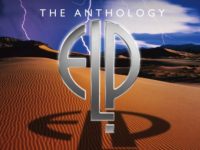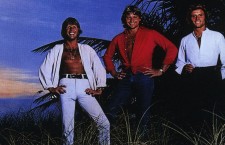For a trio whose biggest single (1972’s “From the Beginning”) barely scratched the Top 40, Emerson Lake and Palmer still came to be associated with several key moments: “Lucky Man,” “Fanfare for the Common Man” and “Tarkus” among them.
This list takes you deeper into their catalog, away from the well-trod grooves of songs like “Karn Evil 9” and into favorite studio moments between ELP’s 1970 debut and their reunion project in 1992 …
“TAKE A PEBBLE,” (EMERSON LAKE AND PALMER, 1970): After an update of Bartok’s “The Barbarian” to open their self-titled debut, Keith Emerson’s trickling piano asides perfectly match Greg Lake’s diaphanous opening lyric — providing the first recorded evidence of the way this trio will combine their respective visions.
Carl Palmer later adds these brilliant water-like percussive elements during the song’s extended middle portion, before Lake’s galloping guitar twang moves the drummer to what feels always felt like spontaneous hand claps and whistles. Emerson’s returns with a grand flourish, improvising with all of the speed of a rushing stream. The song then splashes into a turbulent section, with Lake adding an insistent bass line while Emerson and Palmer tangle and untangle.
Finally, the trio stiffens into a portentous cadence as Lake returns to the lyric, and “Take A Pebble” enters its final, soaring sequence. On an album dominated by what often feel like solo moments (be they the sweeping instrumentals like the aforementioned opener and Emerson’s “Three Fates”; or the smaller, more musicianly moments like “Lucky Man”), “Take A Pebble” finds Emerson Lake and Palmer in full flight — together.
“ENDLESS ENIGMA,” (TRILOGY, 1972): A three-part showcase for the compositional and improvisational abilities of Emerson Lake and Palmer, “Endless Enigma” holds so many musical wonders that it’s easy to become consumed with the work of Emerson and Lake.
Emerson, after all, starts out spooky and dark, then rushes forward into a thunderous outburst while Lake — his vocal instrument at the peak of its powers — moves from sweet reverie to foundation-shaking retorts. And that’s just their co-written Part 1. Emerson then contributes a roughly two-minute fugue that joins the two segments, as “Endless Enigma” comes crashing to a resounding conclusion.
Go back, though, and pay closer attention to Palmer. He’s just as adept at the stick-splintering crashes needed to propel the song to that big finish as he is the song’s angular jazz segments as he is the bass-drum heartbeat that opens “Endless Enigma” — years before the effect became central to albums like Dark Side of the Moon from Pink Floyd and A Passion Play by Jethro Tull.
“BENNY THE BOUNCER,” (BRAIN SALAD SURGERY, 1973): One of the more decidedly lighthearted moments on ELP’s fourth studio album, this tune featured Emerson assuming a ragtime cadence – he even had one of the strings purposely out of tune, to add to the bar-room effect – and a sendup storyline set in a working-class pub.
In this way, “Benny the Bouncer” (nestled amongst both “Toccata,” a rewrite of an Alberto Ginastera piano concerto, and the prog-epic “Karn Evil 9”) becomes another showcase for the sweeping contrasts in Emerson’s playing. “‘Benny the Bouncer,’ that had a really great left-turn stride piano,” Lake told us, in an exclusive Something Else! Sitdown. “A great figure. They made really great vehicles for songs with a humorous edge.”
The lyrics were by Lake and fellow ex-King Crimson member Peter Sinfield, whose contributions here marked the beginnings of a long association with ELP, as well. “Benny,” along with “Jeremy Bender,” “The Sheriff,” “Are Your Ready, Eddy?” and others, show a propensity for humor that not only balanced the deeper conceptual elements of their projects but also remains quite rare in the genre. “In retrospect, I agree,” Lake added. “But at the time, mainly, what they were was Keith Emerson doing this sort of honky-tonk bar piano. He does a lot of those interpretations, and some of them are good. Sometimes he’ll come up with one that’s really nice. And those were the things that were too good to pass by, really.”
“AFFAIRS OF THE HEART” (BLACK MOON, 1992): When Emerson, Lake and Palmer made its long-awaited early-1990s reunion – recording for the first time together with the original lineup since 1978 – Lake brought along something he had composed with Geoff Downes of Asia. In fact, the duo had worked on six tracks in the summer of 1988 as Ride the Tiger, before Downes went back to a newly reformed Asia — with ELP’s Palmer. “Love Under Fire” appeared on Asia’s subsequent release Aqua, while “Affairs of the Heart,” a stoic and pretty ballad, ended up on Black Moon.
“Affairs” starts with this quixotic moment of romantic reverie, and bravely stays there. Emerson slowly insinuates himself, arriving with a few well-placed flourishes rather than an out-sized statement of purpose, then begins quietly building a delicate bed of sound. Lake, singing with a minstrel’s poise, further grounds a tune that might have moved into crunchy overkill in any other era. (For a taste of that, head over to Black Moon’s smart adaptation of “The Dance of the Knights,” from Prokofiev’s Romeo and Juliet.)
You might have expected ELP, after so long away, to come back with a bigger, more showy effort. Instead, this was one of the album’s simpler, very welcome joys.
“THE ONLY WAY (HYMN),” (TARKUS, 1971): Beginning with a wash of suitably churchy asides from Emerson, this song boasts one’s of ELP’s most serrated lyrics, as Lake explores thoughts on a higher being’s place in an existence riven by violence and war: “Can you believe God makes you breathe,” a seething Lake asks at one point. “Why did he lose six million Jews?”
Couple that with the billowing darkness emanating from Emerson’s keyboards — achieved by holding down the F bass pedal on an old pipe organ while simultaneously playing Bach’s “Toccata in F” and “The Sixth Prelude” — and you have an emotional high point on an album dominated by tough anti-war messages. It’s also the anti-thesis, really, of what concurrent bands like Yes were doing with their own florid messages of peace.
Emerson and Palmer apparently blanched at the line referencing the Holocaust, with the keyboardist calling it “disturbing,” but ultimately they went along with the narrative Lake was constructing. Whatever it took for ELP to get to “The Only Way,” it certainly further defined their unique brand of creative synthesis.
- How Deep Cuts on ‘Music From Big Pink’ Underscore the Band’s Triumph - July 31, 2023
- How ‘Islands’ Signaled the Sad End of the Band’s Five-Man Edition - March 15, 2022
- The Band’s ‘Christmas Must Be Tonight’ Remains an Unjustly Overlooked Holiday Classic - December 25, 2016




